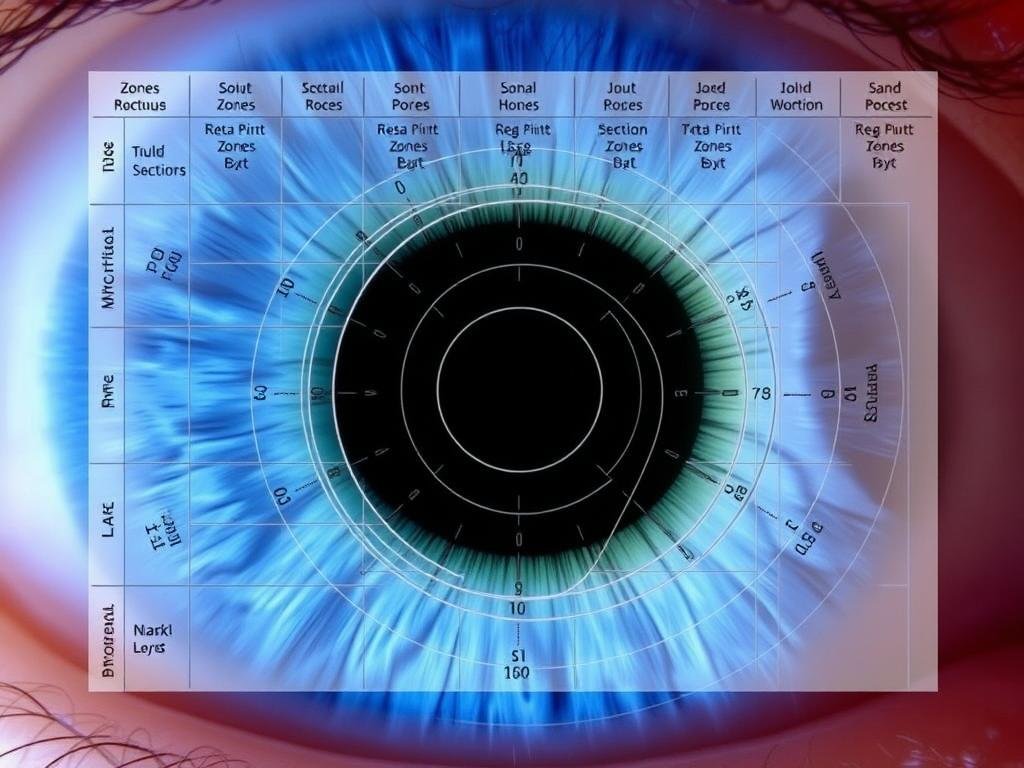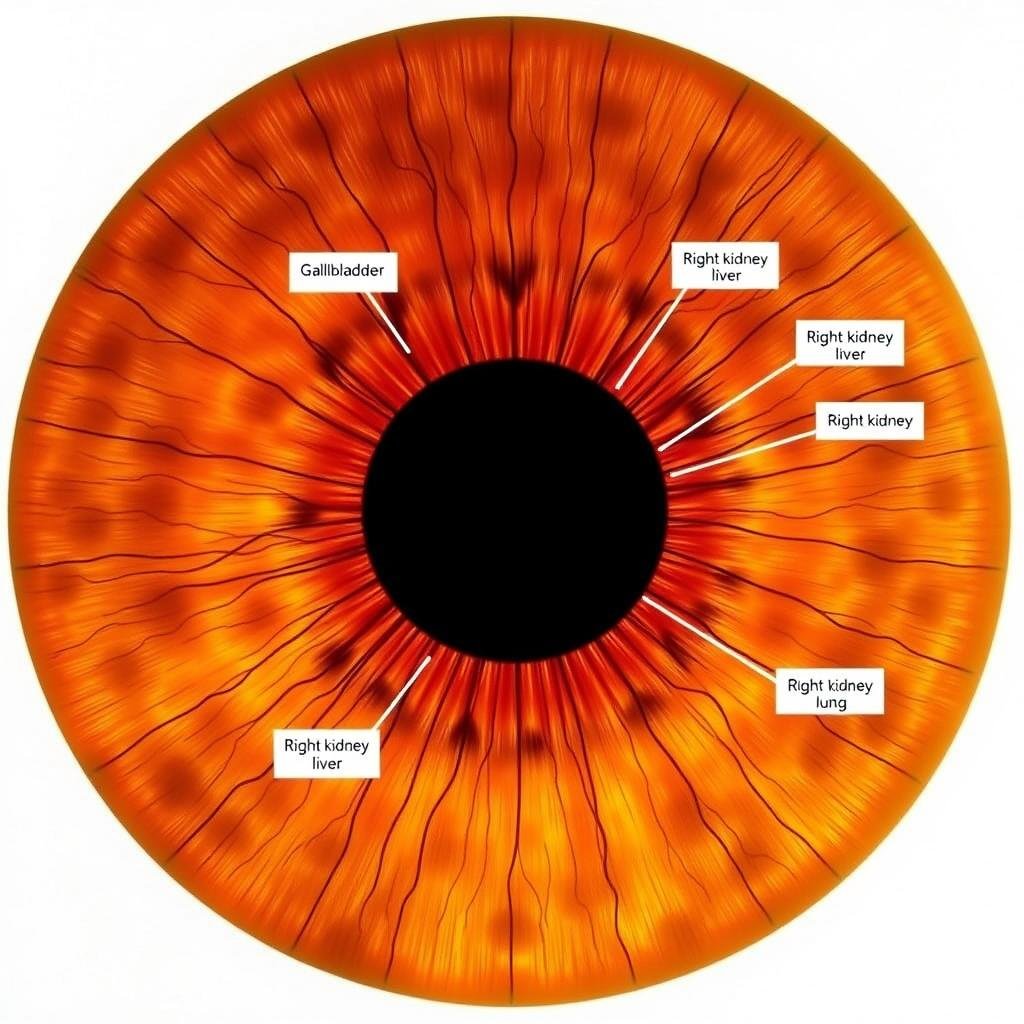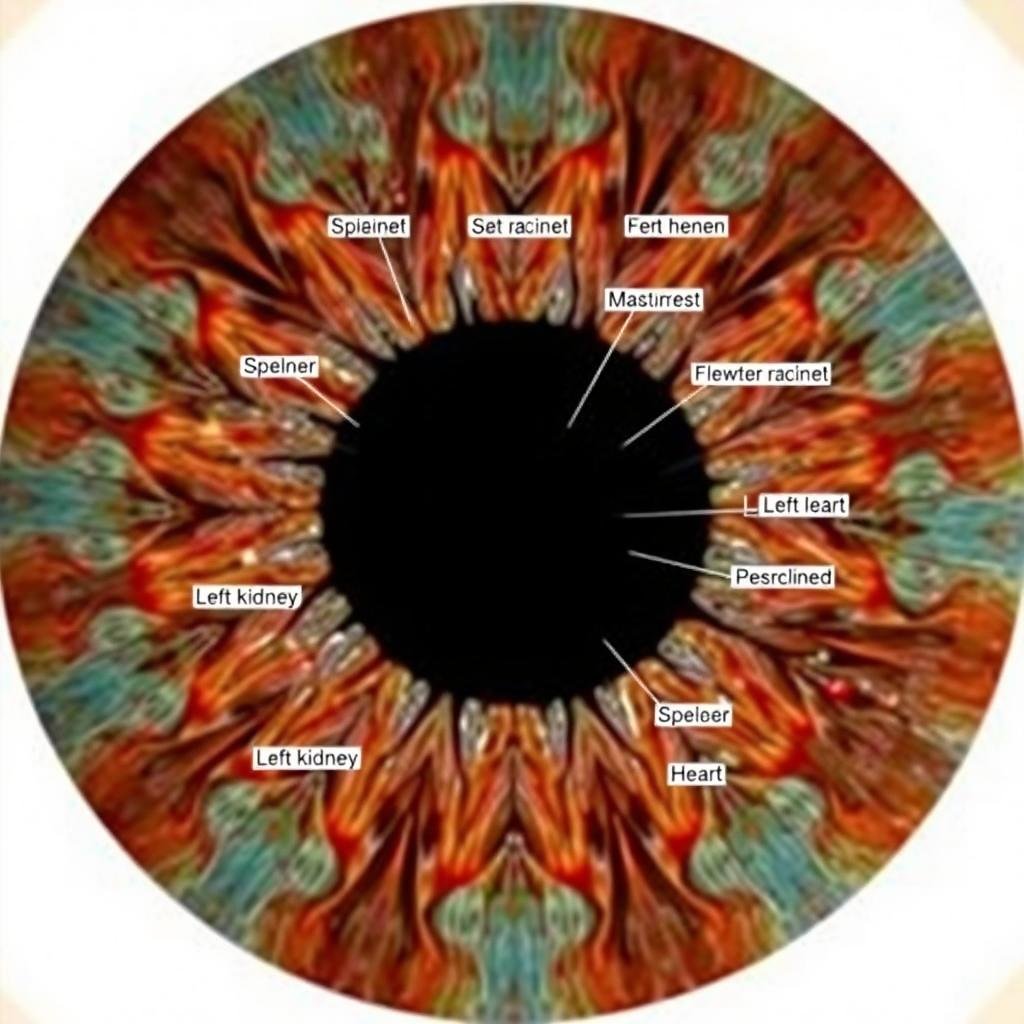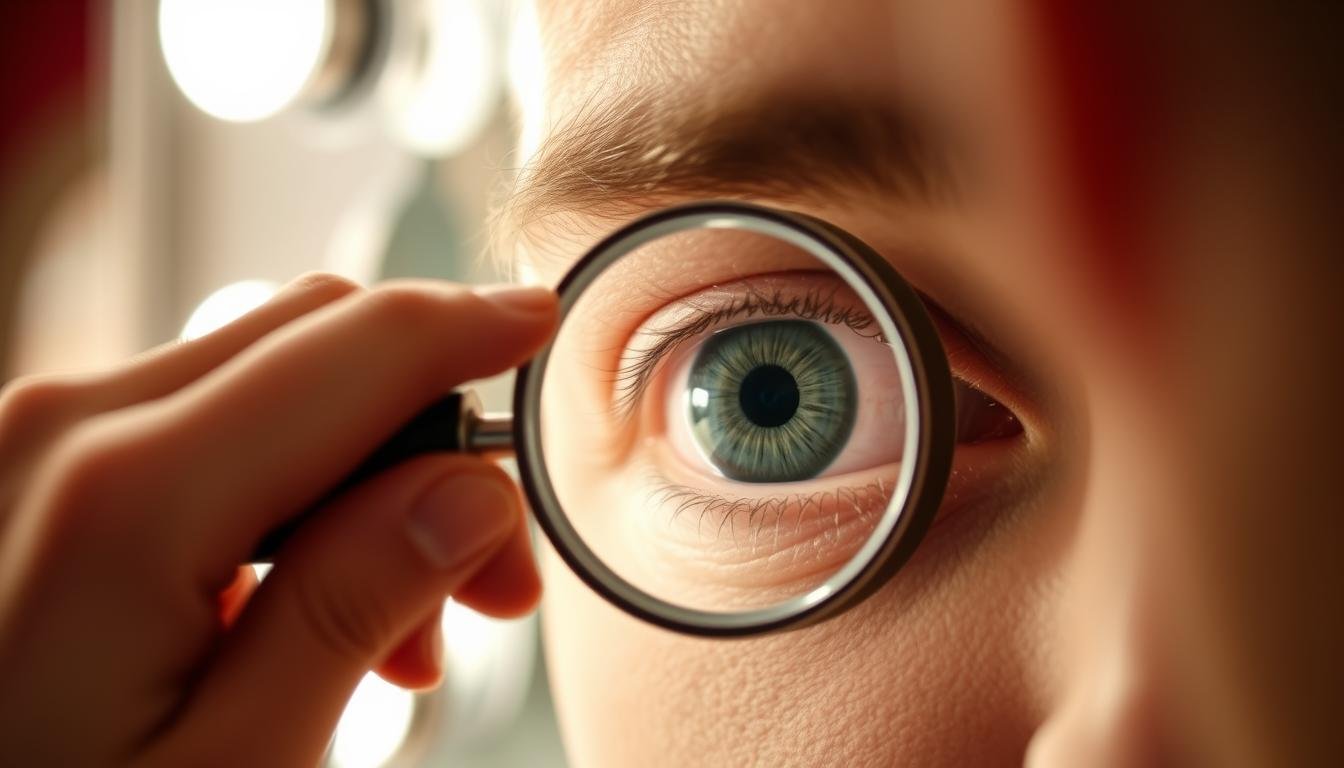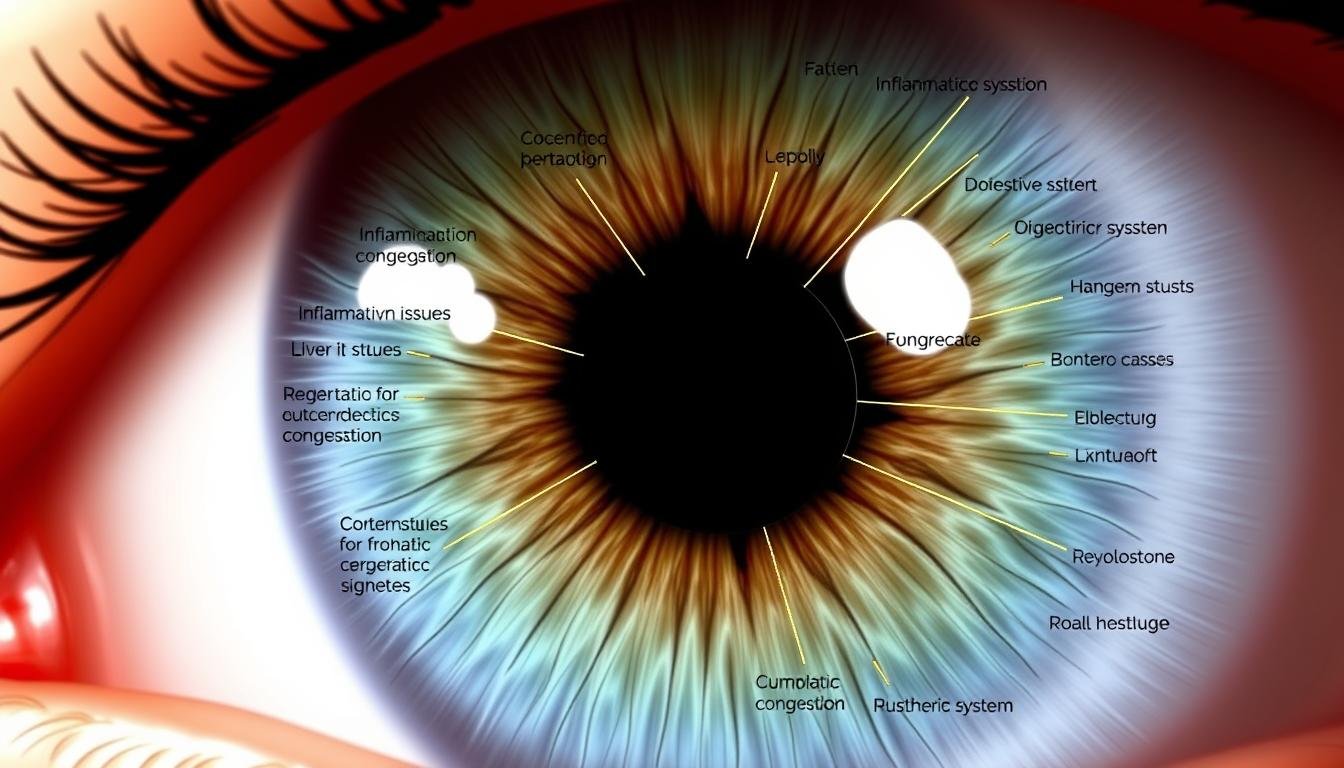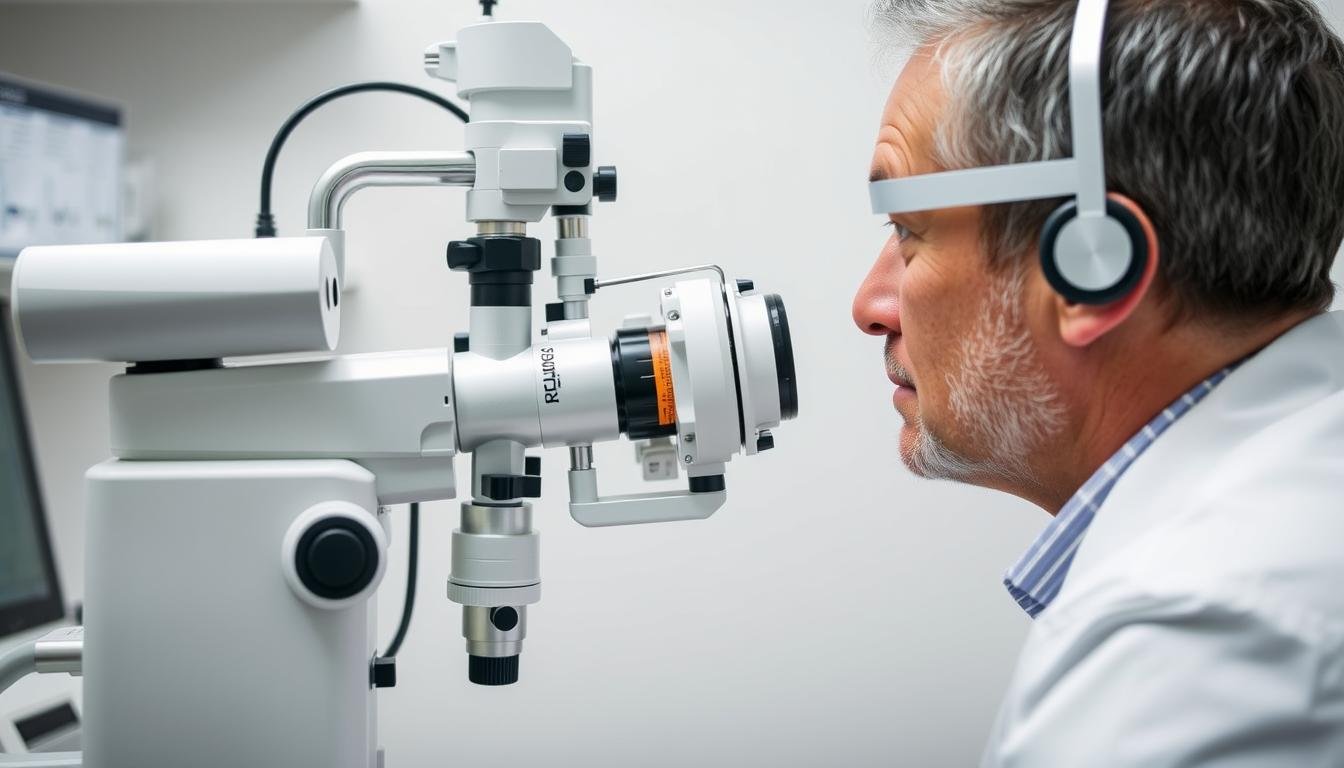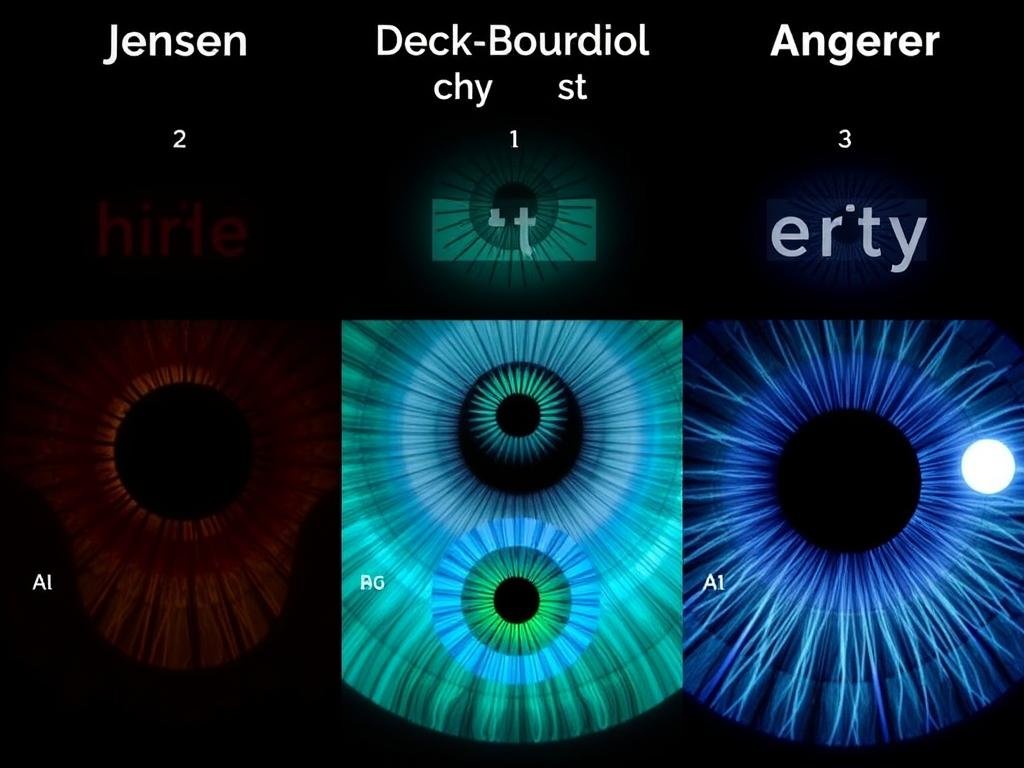El iris humano contiene patrones intrincados tan únicos como las huellas dactilares. Los gráficos de iridología asignan estos patrones a diferentes sistemas del cuerpo, creando una ventana fascinante a posibles condiciones de salud. Esta guía completa explora cómo los profesionales utilizan las tablas de iridología, sus orígenes históricos y el debate actual sobre su eficacia en la medicina alternativa.
¿Qué es una tabla de iridología?
Un tabla de iridología Sirve como un mapa detallado que divide el iris en zonas, cada una correspondiente a diferentes órganos y sistemas dentro del cuerpo. Los médicos utilizan estos gráficos para analizar el color, la textura y las marcas del iris para identificar posibles desequilibrios de salud antes de que se manifiesten como síntomas físicos.
Un gráfico de iridología estándar que asigna las zonas del iris a los sistemas corporales correspondientes.
Estos gráficos especializados proporcionan un marco para que los iridólogos interpreten lo que observan en sus ojos. Si bien la medicina convencional sigue siendo escéptica, sus defensores creen que estos gráficos ofrecen información sobre las fortalezas, debilidades y posibles problemas de salud de su cuerpo.
Los orígenes históricos de los gráficos de iridología
La práctica de examinar el iris en busca de información sobre la salud se remonta a miles de años y tiene sus raíces en el antiguo Egipto, China y la India. Sin embargo, las cartas iridológicas modernas surgieron en el siglo XIX gracias al trabajo del médico húngaro Ignatz von Peczely.

Ignatz von Peczely, considerado el padre de la iridología moderna
Cuando era niño, von Peczely notó cambios en el iris de un búho después de que el pájaro sufriera una fractura en una pata. Esta observación provocó su estudio de toda la vida sobre la conexión entre las marcas del iris y la salud física. En 1880, publicó el primer gráfico iridológico completo, que mapeaba zonas específicas del iris para órganos y sistemas corporales.
A lo largo del siglo XX, profesionales como Bernard Jensen refinaron aún más estos gráficos, creando los sistemas de mapeo detallados que utilizan los iridólogos modernos en la actualidad. Estos gráficos en evolución reflejan décadas de observación y documentación por parte de profesionales de la salud alternativa.
Componentes clave de una tabla de iridología
Comprender cómo leer un tabla de iridología requiere familiaridad con sus componentes fundamentales. Cada gráfico suele dividir el iris en zonas concéntricas y secciones radiales, creando un mapa completo del cuerpo.


Superposición de gráficos de iridología en un iris humano que muestra zonas de mapeo
Secciones principales de una tabla de iridología
- Zona pupilar – El área que rodea inmediatamente a la pupila, asociada con el sistema digestivo y el estómago.
- Collarette/Corona de nervio autónomo – El límite irregular que separa la zona pupilar de la zona ciliar, que representa el sistema nervioso autónomo.
- Zona ciliar – El área media del iris, que contiene marcas relacionadas con la mayoría de los órganos y tejidos.
- Borde/periferia del iris – El borde exterior del iris, asociado con la piel, el sistema linfático y la circulación.
- Zonas Radiales – Secciones en forma de pastel que se extienden desde la pupila hasta el borde, cada una vinculada a órganos específicos
- Lagunas – Áreas cerradas, a menudo oscuras, que indican posibles debilidades inherentes
- Criptas – Áreas abiertas, generalmente más claras, que sugieren condiciones agudas.
Cada iris se divide además en aproximadamente 60 sectores correspondientes a diferentes partes del cuerpo. El iris derecho generalmente refleja el lado derecho del cuerpo, mientras que el iris izquierdo corresponde al lado izquierdo.
Interpretación del iris derecho e izquierdo
Las cartas de iridología suelen mostrar diferentes asignaciones para el iris derecho e izquierdo, ya que se cree que cada uno corresponde a diferentes lados y sistemas del cuerpo.


Mapeo del gráfico del iris derecho
Correlaciones del iris derecho
- Cerebro y lado derecho de la cabeza.
- Pulmón derecho y bronquios.
- Hígado y vesícula biliar
- riñón derecho
- Colon ascendente y transverso
- Órganos reproductivos correctos

Mapeo del gráfico del iris izquierdo
Correlaciones del iris izquierdo
- Lado izquierdo del cerebro y la cabeza.
- Corazón y pulmón izquierdo
- Estómago y bazo
- Riñón izquierdo
- Colon descendente
- Órganos reproductivos izquierdos
Los profesionales analizan ambos iris juntos para formar una imagen completa del estado de salud del cuerpo. Las asimetrías entre los ojos pueden indicar desequilibrios que requieren atención.
Para que el diagnóstico sea más preciso, tabla de iridología A menudo se utiliza junto con otros métodos de diagnóstico.

Gráfico de iridología Ojo derecho -Iridología Tabla -Ojo derecho
ojo derecho reflejes lado derecho cuerpo.
| Posición del reloj (ojo derecho) | Corresponde órgano/sistema | Detalles |
|---|
| 1 en punto - 2 en punto | Cara derecha | Corresponde a los órganos reproductivos izquierdos, incluyen útero, ovarios (hembras) o testículos (hombres). |
| 2 en punto - 3 en punto | Garganta
| Ringflects Health Juntas izquierdas, incluye rodillas, caderas, codos y hombros. |
| 3 en punto - 4 en punto | Espalda superior derecha
| Corresponde a la columna vertebral, la salud espinal, la alineación y la flexibilidad. |
| 4 en punto - 5 en punto | Vejiga | Ringflects Bladder y Sistema urinario del lado derecho. |
| 5 en punto - 6 en punto | Pélvico derecho | Anlingpresents izquierda colon, intestino delgado y salud digestiva. |
| 6 en punto - 7 en punto | Abdomen inferior derecha
| Ringflects izquierdo de riñón, se centra en la filtración, la desintoxicación y el equilibrio de fluidos. |
| 7 en punto - 8 en punto | Abdomen superior derecho
| Ringflects estómago y órganos digestivos en el lado izquierdo. |
| 8 en punto - 9 en punto | Tórax derecho | Corresponde al hígado del lado izquierdo, la desintoxicación responsable y la producción de bilis. |
| 9 en punto - 10 en punto | Pulmón derecho | Los ritmo del corazón del lado izquierdo, afectan la salud y la circulación cardiovascular. |
| 10 en punto - 11 en punto | Cuello derecho | Ringflects Left Lunm, salud respiratoria y función Brea. |
| 11 en punto - 12 en punto | Cerebro derecho
| Corresponde al cerebro del hemisferio izquierdo, la salud mental y las funciones cognitivas. |
| 12 en punto - 1 en punto | Cerebro derecho
| Corresponde al cerebro del hemisferio izquierdo, la salud mental y las funciones cognitivas. |

Gráfico de iridología ojo izquierdo - Gráfico de iridología - Ojo izquierdo
ojo izquierdo reflejes lado izquierdo cuerpo.
| Posición del reloj (ojo izquierdo) | Corresponde órgano/sistema | Detalles |
|---|
| 1 en punto - 2 en punto | Cuello izquierdo
| Corresponde a los órganos reproductivos derecho, incluyen útero, ovarios (hembras) o testículos (macho). |
| 2 en punto - 3 en punto | Pulmón izquierdo | Ringflects Health Right Junks, incluyen rodillas, caderas, codos y hombros. |
| 3 en punto - 4 en punto | Tórax izquierdo | Corresponde a la columna vertebral, la salud espinal, la alineación y la flexibilidad en el lado derecho. |
| 4 en punto - 5 en punto | Abdomen de la parte superior izquierda
| Ringflects Bladder y Sistema urinario del lado izquierdo. |
| 5 en punto - 6 en punto | Abdomen inferior izquierdo
| Anillo de anillo de colon derecho, intestino delgado y salud digestiva. |
| 6 en punto - 7 en punto | Pélvico izquierdo
| Ringflects riñón derecho, se centra en la filtración, la desintoxicación y el equilibrio de fluidos. |
| 7 en punto - 8 en punto | Izquierda hacia atrás
| Ringflects estómago y órganos digestivos en el lado derecho. |
| 8 en punto - 9 en punto | Izquierda de la parte superior de la espalda
| Corresponde al hígado del lado derecho, la desintoxicación responsable y la producción de bilis. |
| 9 en punto - 10 en punto | Garganta izquierda
| Antes de anillo del corazón del lado derecho, afectan la salud y la circulación cardiovascular. |
| 10 en punto - 11 en punto | Cara izquierda | Ringflects pulmón derecho, salud respiratoria y función Brea. |
| 11 en punto - 12 en punto | Cerebro izquierdo | Corresponde al cerebro del hemisferio derecho, la salud mental y las funciones cognitivas. |
| 12 en punto - 1 en punto | Cerebro izquierdo | Corresponde al cerebro del hemisferio derecho, la salud mental y las funciones cognitivas. |
- Ojo derecho: Ringflects Lado derecho cuerpo (por ejemplo, Bien riñón, Bien pulmón, Bien órganos reproductivos, etc.).
- Ojo izquierdo: Ringflects Lado izquierdo cuerpo (por ejemplo, Izquierda riñón, Izquierda pulmón, Izquierda órganos reproductivos, etc.).
Interpretación de los colores y marcas del iris
Más allá del mapeo zonal, los gráficos de iridología incluyen pautas para interpretar varios colores, texturas y marcas que se encuentran en el iris. Estas funciones proporcionan capas adicionales de información sobre posibles condiciones de salud.

Marcas comunes del iris y sus interpretaciones en iridología.
Signos comunes del iris y sus significados
| Característica de iris | Apariencia | Indicación potencial |
| Anillos blancos | Líneas circulares blancas alrededor del iris. | Posible colesterol alto o tensión arterial. |
| Manchas oscuras | Motas marrones o negras | Posible acumulación de toxinas o daño a órganos. |
| Líneas radiales | Líneas que se extienden desde la pupila hasta el borde del iris. | Estrés nervioso o problemas de circulación. |
| tinte amarillo | Decoloración amarillenta | Posible estrés renal o hepático. |
| Lagunas | Áreas cerradas, oscuras, a menudo ovaladas. | Debilidad inherente en el órgano correspondiente. |
| Rosario linfático | Puntos blancos formando un círculo. | Congestión del sistema linfático |
El color del iris también juega un papel importante en el análisis de iridología. Los iris azules (constitución linfática) pueden indicar tendencias diferentes a los iris marrones (constitución hematogénica) o iris mixtos (constitución biliar).
Cómo utilizar una tabla de iridología en casa
Si bien la iridología profesional requiere capacitación y experiencia, puedes realizar una observación básica del iris en casa. Esta autoevaluación preliminar podría generar ideas que valga la pena discutir con un profesional calificado.

Autoexamen básico utilizando iluminación y aumento adecuados.
Pasos para el autoexamen básico del iris
- Reúna el equipo: Una pequeña linterna, lupa y espejo en un área bien iluminada.
- Iluminación de posición: Coloque la fuente de luz en un ángulo de 45 grados con respecto a su ojo para evitar reflejos.
- Examina cada iris: Busque variaciones de color, marcas, anillos y manchas
- Comparar con un gráfico: consulte un cuadro de iridología básico para comprender lo que está viendo
- Observaciones del documento: Tome notas o fotografías para realizar un seguimiento de los cambios a lo largo del tiempo
- Consulta a un profesional: Comparta sus observaciones con un iridólogo capacitado para una interpretación adecuada.
¿Quiere saber más sobre el análisis del iris?
Descargue nuestra guía de referencia completa de tablas de iridología para comenzar su viaje hacia la comprensión de lo que sus ojos pueden revelar sobre su salud.
Descargue la guía gratuita de gráficos de iridología
Recuerde que la autoevaluación es meramente educativa y no debe reemplazar el asesoramiento médico profesional ni el diagnóstico de proveedores de atención médica calificados.
Condiciones de salud que la iridología pretende detectar
Los practicantes de iridología creen que varias marcas y patrones en el iris pueden indicar posibles problemas de salud en los sistemas corporales correspondientes. Si bien la evidencia científica sigue siendo limitada, estas son algunas condiciones que los iridólogos comúnmente afirman identificar mediante el análisis del iris.

Mapeo iridológico de condiciones de salud comunes en las regiones del iris.
Sistema digestivo
- Inflamación intestinal
- Problemas de acidez de estómago
- Preocupaciones por la malabsorción
Sistema circulatorio
- Tendencias de la presión arterial
- Eficiencia de circulación
- Indicaciones de colesterol
Sistemas de eliminación
- Estrés de riñones y vejiga
- Congestión del hígado
- Estancamiento del sistema linfático
Los iridólogos enfatizan que estas indicaciones representan tendencias o predisposiciones más que diagnósticos definitivos. El iris puede mostrar debilidades constitucionales que podrían convertirse en problemas de salud si no se abordan mediante modificaciones en el estilo de vida.
¿Tienes curiosidad por saber lo que revela tu iris?
Conéctese con un practicante de iridología certificado para un análisis personalizado de sus patrones de iris y lo que podrían indicar sobre sus tendencias de salud.
Encuentre un iridólogo cerca de usted
La perspectiva científica de la iridología
Si bien la iridología tiene defensores apasionados, es importante comprender la perspectiva de la comunidad científica. La medicina convencional ha realizado varios estudios controlados que examinan las afirmaciones diagnósticas de la iridología con resultados mixtos.
Los defensores argumentan
- El iris contiene más de 28.000 fibras nerviosas conectadas al cerebro.
- Historias de éxito anecdóticas respaldan su eficacia
- Ofrece un enfoque no invasivo para la evaluación de la salud.
- Puede detectar desequilibrios antes de que aparezcan los síntomas.
Los críticos señalan
- Una investigación limitada revisada por pares respalda sus afirmaciones
- Los estudios controlados muestran una precisión diagnóstica inconsistente
- Los patrones del iris están determinados en gran medida por la genética.
- Posible retraso en la búsqueda de tratamiento médico convencional

El examen oftalmológico moderno se diferencia del análisis iridológico
La mayoría de las organizaciones médicas, incluida la Academia Estadounidense de Oftalmología, no reconocen la iridología como un método de diagnóstico válido. Sin embargo, algunos profesionales de la salud integral lo incorporan como un componente de una evaluación de salud holística en lugar de una herramienta de diagnóstico independiente.
Preguntas frecuentes sobre listas de iridología
¿Qué tan precisas son las tablas iridológicas para diagnosticar condiciones de salud?
La precisión de la iridología sigue siendo controvertida. Si bien los profesionales informan que han logrado identificar tendencias de salud, los estudios científicos han producido resultados inconsistentes. La mayoría de los profesionales médicos consideran que los gráficos iridológicos son insuficientes para el diagnóstico médico. Pueden proporcionar información sobre las tendencias constitucionales, pero no deberían reemplazar las pruebas médicas convencionales.
¿Pueden las cartas iridológicas detectar enfermedades graves como el cáncer?
Los iridólogos responsables no pretenden diagnosticar enfermedades específicas como el cáncer mediante el análisis del iris. En cambio, pueden identificar áreas de estrés o debilidad en los sistemas del cuerpo. Cualquier hallazgo preocupante debe provocar una consulta con profesionales médicos para realizar las pruebas de diagnóstico adecuadas.
¿Los patrones del iris cambian con el tiempo?
Si bien la estructura básica y el color del iris permanecen relativamente estables durante toda la vida, los iridólogos creen que ciertas marcas pueden cambiar para reflejar el estado de salud. Estos cambios suelen ocurrir gradualmente y pueden reflejar condiciones de salud a largo plazo en lugar de problemas agudos.
¿Son todas las cartas de iridología iguales?

Comparación de tres principales sistemas de cartas iridológicas que muestran variaciones en el mapeo
Conclusión: el lugar de las tablas iridológicas en la evaluación de la salud
Los gráficos de iridología representan una intersección fascinante entre la observación antigua y las prácticas de salud alternativas. Si bien continúan generando debate en los círculos médicos, muchas personas encuentran valor en la perspectiva holística que ofrecen.
Ya sea que se acerque a la iridología con entusiasmo o escepticismo, comprender estos intrincados mapas del iris proporciona información sobre un método único de evaluación de la salud con una larga tradición histórica. Como ocurre con cualquier enfoque de salud, el equilibrio es clave: considere la iridología como una herramienta potencial en una estrategia de salud integral en lugar de un sistema de diagnóstico independiente.
Para aquellos intrigados por lo que sus ojos podrían revelar, consultar tanto con profesionales médicos convencionales como con practicantes de iridología calificados ofrece el enfoque más equilibrado para la evaluación y el mantenimiento de la salud.




